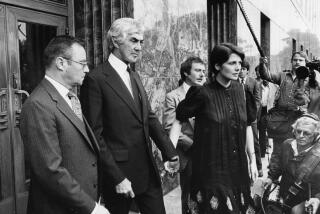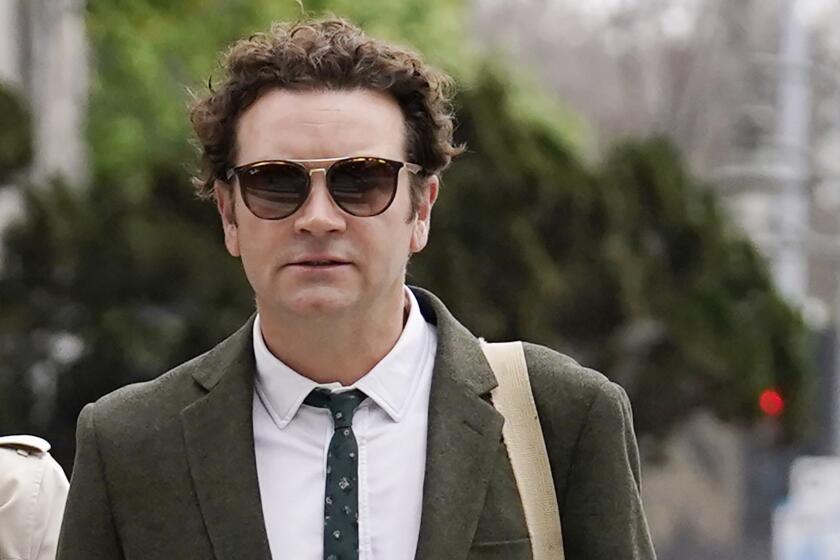And the pitch is ... wild
FIRST, some back story. It’s World War II, and U.S. carmakers have shifted to more important products — jeeps and anything else that would help fill the Army’s arsenal. With new cars in short supply, dealers become hungrier sharks, having to work harder to sell vehicles that were past their prime.
Enter Madman Muntz, who was so young when he began selling cars back in Illinois that his mother had to sign sales papers.
Starting in the early ‘40s, Earl Muntz began caravaning cars from Illinois to his car lots in Glendale and downtown L.A., selling them at twice the price he’d paid back in Chicago. With ad whiz Mike Shore crafting the copy, he did a ferocious business, particularly right after the war, using radio and TV in ways no one else dared.
Dressed in red BVDs and a Napoleonic hat, he would scream: “I want to give them away, but Mrs. Muntz won’t let me. SHE’S CRAZY!”
It was the shout heard ‘round the Southland, the beginning of a circus of the cars that would feature dealers hanging from airplanes, smashing Chevys with sledgehammers and sharing late-night screen time with dogs, elephants, alligators and whales. These brazen wheeler-dealers became a wacky part of the Southern California landscape from the early 1940s to the late ‘80s, offering up audacious performances to a town that appreciated pluck and stagecraft. After all, even Brando couldn’t chew scenery like Cal Worthington’s live gorilla.
Now, of course, the business of selling cars is all button-down, “Mr. This and Ms. That,” and “Can I get you a cup of espresso with your lease agreement?” But in their time, guys like Madman Muntz owned the airwaves.
“I had a little trouble getting here,” Bob Hope told a nationwide radio audience after being pushed onstage in an old Model T. “Madman Muntz chased me for three blocks!”
Muntz and Shore — the Madman and the adman — saturated the market with their ads. “There were 9,000 dealers out here then and they were all the same,” remembers Shore, now 89. “I told Muntz that I wanted to do something different, and he said, ‘Go ahead.’ ”
“I had an animator at Warner [Bros. Studios] draw up the little Napoleon figure,” Shore says. “Then Muntz put on the costume. He lived it up. It really transformed him.”
“I buy ‘em retail and sell ‘em wholesale,” Muntz would scream to potential customers. “It’s more fun that way!” At Shore’s urging, he posted billboards everywhere, and at one time ran up to 170 radio spots a day, by some accounts.
The gregarious dealer would do nearly anything to get noticed. During the McCarthy era, Muntz once asked an advisor, “Do you think I’d make the front pages if I joined the Communist Party?”
“He’d sell $72 million worth of cars and keep $1 million,” remembers his son, James Muntz, now a computer engineer in Florida. “That’s how much he’d discount.”
In his heyday, Muntz’s lots became stops on celebrity bus tours. At one USC vs. UCLA game, pranksters spelled out M-U-N-T-Z in a card stunt.
Muntz collected several fortunes and even more careers before his death in 1987. He coined the term “TV” when skywriters ran out of gas before finishing their ads for his television sets — and he later named his daughter TeeVee. He developed one of the earliest sports cars, the beautiful Muntz Jet and, as one of the first major players in car stereos, he invented the four-track tape, predecessor to the eight-track. And he married eight times (perhaps Muntz should’ve invented the prenup as well).
But it was for those preposterous auto ads that the Madman is best remembered.
“Earl Muntz worked hard, lived large and always stayed two campfires ahead,” says filmmaker Dan Bunker who, with his wife, Judy ver Mehr, produced a documentary on him. “What set Muntz apart was his chutzpah . He took chances, risked failure and reaped the rewards.”
Certainly, there were plenty of rewards to go around. The era featured other dealer stars as well, including Worthington and Ralph Williams, who would also become rich and ubiquitous celebrities to a customer base that worshiped cars and showbiz.
The roster of such hucksters included Walter Wellman, “the Smiling Irishman”; and Tony Holzer, known for a brief time as “Hog Wild Tony Holzer, a Bundle of Bedlam in Beverly Hills.” At one point, he worked across the street from Muntz and, wearing a robe and halo, took on the tag “Honest John.”
Most memorable of all, of course, was Worthington, whose stunts atop elephants and airplanes made him the main event in this high-stakes show.
A veteran of the Army Air Corps with no job in sight, Worthington started out by using his own car to hone his sales pitch, parking his Hudson Terraplane in front of a Texas post office and approaching passersby on the street.
“Yep, once I found somethin’ I liked doin’, I decided to do it to everybody,” he explained later.
In 1950, he came to California and paid Muntz $26,000 for a Hudson dealership. A year later, he became the first car dealer to videotape a commercial. He also hosted “Cal’s Corral” and “Country Music Time,” music shows featuring up-and-comers Johnny Cash, Glen Campbell and Buck Owens. Such showmanship was rampant by then; simple, witty, populist marketing swept the Southland.
In the 1960s, the genre took another turn. Williams’ sidekick, Chick Lambert, began doing commercials with his dog, Storm. Another dealer, Fletcher Jones, appeared on camera cuddling a puppy in his arms and offering to donate money to dog shelters with every sale.
This sentimental shtick bothered the edgier Worthington, who decided to spoof his competitors by trotting out pets of his own. His most famous commercials — the “My Dog Spot” spots — began in 1971, with a gorilla snarling and stomping in the background.
“Howdy, I’m Cal Worthington and this is my dog Spot,” he said in the ad. “I found this little fella down at the pound and he’s so full of love.”
Worthington’s stunts included hanging upside down from an airplane wing (“I will stand upon my head to beat all deals”), but his biggest triumphs were with the various critters — all dubbed “Spot” — which included almost anything but an actual dog: a tiger, camel, elephant, penguin, porcupine, bear, lizard and Shamu the killer whale, which Cal rode bareback at SeaWorld.
His real gift, perhaps, was a healthy dose of Texas sass, which made him a media darling in a town that knew the commercial value of the great quip. “To tell you the truth, I don’t much care for the car business,” he once said. “In fact, I don’t even like cars. What I like is Italian food, French wine and American women.”
You couldn’t tell from the fun he was having in his ads, which landed him as a guest on “The Tonight Show.” In one famous bit, a goose soiled Worthington’s white suit, and Johnny Carson said, “Be glad it wasn’t that elephant sitting on your lap.”
Meanwhile, “Go see Cal, go see Cal, go see Cal ,” the Worthington jingle, played like a voodoo mantra across the Southland. Ultimately, though, it became apparent that behind these TV high jinks were real-life high jinks.
In the ‘50s, here’s how buying a car often worked: A salesman would snatch your trade-in and hide it on the roof, in case you wanted to walk out before a deal could be reached.
If you found something new you liked, you might agree to terms only to discover the numbers had changed when you went to sign the contract. Or, you might find some numbers left blank on the contract, to be filled in later by your salesman friends.
“Every speedometer was flipped back; it was just so common,” remembers William L. Plunkett of San Marino, who began selling Studebakers in Beverly Hills in 1951. “You’d figure out how old the car was, then multiply by 10,000 or 12,000; that’s what the odometer would read. You wouldn’t dare do that today.”
In the late ‘50s, grand juries convened and dozens of witnesses testified about altered contracts and trade-in scams. Eventually one dealer, H.J. Caruso, and a half-dozen of his associates served jail time. Even Worthington suffered an inglorious third act, when General Motors refused his bid for dealerships in the mid-’90s, saying he had weak customer-service ratings at other GM lots.
Worthington is now living at his mega-ranch in Northern California. The zany ads that he and others pioneered now belong to mattress and electronics stores.
The old-time car dealers “just went out and did it, without subjecting themselves to the tyranny of the focus group,” says Jonathan Taplin, a professor of communication at USC’s Annenberg School. “They were the reason to watch late-night TV.”
He notes that local retailers have taken a hit, and national chains often control markets, driving away the quirky pitchmen who distinguished one city from another.
“The flamboyance and the lack of restraint are gone,” said Plunkett, who wound up running his own VW dealership in the ‘60s and ‘70s. “It was very much footloose and fancy-free.”
Shore, Muntz’s adman, recalls putting up his first billboards along Sunset Boulevard, the precursors to today’s gigantic and far glitzier versions. As an advertising executive, he prided himself on the shtick he created for Madman Muntz and his simple but shrewd campaign.
“We tried to do it with cleverness,” Shore recalls. “These guys screaming about mattresses and such today, they just give me an earache.”
Nostalgic? Well, the beloved, bizarre hucksters are indeed gone from the car lots of Los Angeles. But they haven’t disappeared.
Just look a little to the east, and you’ll find Chop, Chilly Willy and the Blue Genie pushing acres of Dodges out the door in Las Vegas.
At Towbin Dodge, Chop — a blingy, refrigerator-size rap-style character otherwise known as Josh Towbin — is the star, hamming it up in TV ads, on late-night talk shows with Jay Leno and Jimmy Kimmel and in the “King of Cars,” an A&E reality series about life on the big lot. Chop’s salesmen paint their bodies blue (the Genie, naturally), among other things. Their dealership is called “the castle” and their antics? Think bikini oil wrestling, among other things.
The legacy lives on.
Chris Erskine is the editor of Highway 1. He can be reached at chris.erskine@latimes.com.
More to Read
Sign up for Essential California
The most important California stories and recommendations in your inbox every morning.
You may occasionally receive promotional content from the Los Angeles Times.











